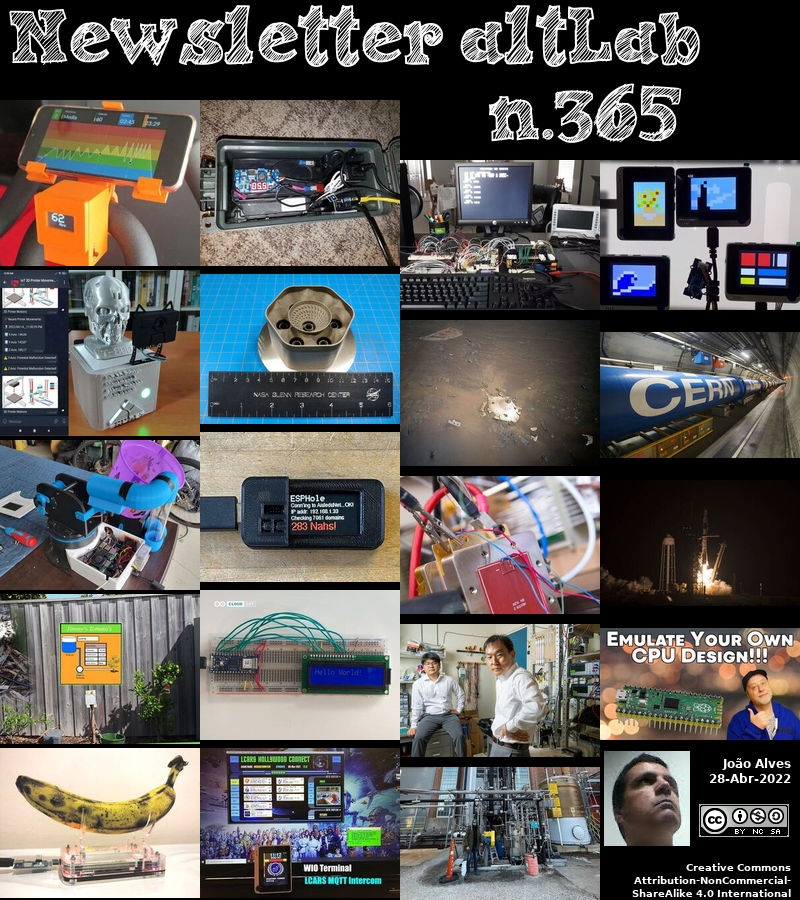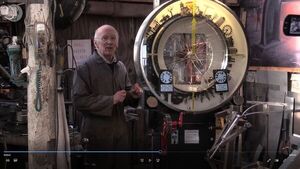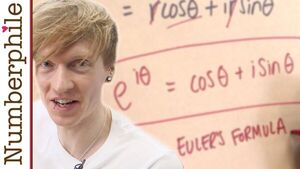2022-04-28 - Nº 365
Editorial
Esta é a Newsletter Nº 365 que se apresenta com o mesmo formato que as anteriores. Se gostar da Newsletter partilhe-a!
Todas as Newsletters encontram-se indexadas no link.
Esta Newsletter tem os seguintes tópicos:
Faz hoje anos que nascia, em 1753, o químico e físico experimental alemão Franz Karl Achard. Ele inventou um processo para a extracção em grande escala de açúcar de mesa (sacarose) da beterraba, e em 1801, abriu a primeira fábrica de beterraba, na Silésia (actualmente Polónia). No início, embora simples, o método era dispendioso, melhorou-o utilizando sugestões do Instituto em França, incluindo que as beterrabas fossem prensadas sem serem cozinhadas, o que poupou muitas despesas de combustível. Ele tinha sucedido Andreas Sigismund Marggrafupon na sua morte (1782) como director da "Classe de Física" na Academia de Berlim. Foi Marggraf que descobriu pela primeira vez a presença de açúcar na raiz da beterraba, e isolou-a numa escala experimental em 1747. Achard descobriu também um método para trabalhar a platina e foi o primeiro a preparar um cadinho de platina (1784).
Faz também hoje anos que nascia, em 1831, o físico e matemático escocês Peter Tait. Ele ajudou a desenvolver quaternions, que promoveu fortemente, e escreveu um tratado padrão sobre o assunto. O seu trabalho ajudou a fazer avançar a física matemática moderna. Tait fez muito trabalho experimental em termodinâmica, e apresentou uma série de artigos sobre a teoria cinética dos gases (1886-92). Dos seus muitos livros sobre física, o seu mais conhecido foi co-autor com William Thomson (mais tarde Lord Kelvin), um livro de física matemática, Treatise on Natural Philosophy (1876). Para além de investigar o ozono, gases e electricidade, Tait criou um aparelho para emitir grandes anéis de vórtice de fumo estáveis. A partir de outros trabalhos experimentais, construiu modelos matemáticos do voo de uma bola de golfe.
Faz igualmente hoje anos que nascia, em 1854, a engenheira electrotécnica, inventora e matemática inglesa Hertha Ayrton. Ela inventou um esfigmógrafo (um dispositivo que traça batidas de pulso, embora não o primeiro), um divisor de linhas (um instrumento de desenho para dividir uma linha num determinado número de partes iguais, 1884) e um ventilador anti-gás (flapper) utilizado durante a Primeira Guerra Mundial. Começou a trabalhar com William Ayrton, com quem se casou posteriormente (1884). Retomando o interesse do seu marido em experiências de arco eléctrico, Hertha concebeu melhorias que tornaram as luzes de arco mais silenciosas e mais fiáveis. Ela publicou The Electric Arc (1902). Como mulher, foi-lhe negada uma licenciatura de Cambridge, e no início recusou-se a ser membro da Royal Society (1902).
Faz também hoje anos que nascia, em 1900, o físico e astrónomo holandês Jan Oort. Ele foi uma das figuras mais importantes nos esforços do século XX para compreender a natureza da galáxia da Via Láctea, que mediu a rotação da galáxia da Terra e formulou a hipótese de uma "Nuvem de Oort". Em 1927 Oort analisou movimentos de estrelas distantes, encontrou provas de rotação diferencial e fundou a teoria matemática da estrutura galáctica. Após a Segunda Guerra Mundial, liderou o grupo holandês que utilizou a linha de 21 cm para mapear o gás hidrogénio na Galáxia. Encontraram a estrutura espiral em grande escala, o centro galáctico, e os movimentos das nuvens de gás. Em 1950 Oort propôs o modelo agora geralmente aceite para a origem dos cometas.
Faz igualmente hoje anos que nascia, em 1906, o matemático Kurt Gödel. Ele é conhecido pela sua prova dos Teoremas de Incompletude de Gödel (1931) Ele provou resultados fundamentais sobre sistemas axiomáticos, mostrando que em qualquer sistema matemático axiomático existem propostas que não podem ser provadas ou refutadas dentro dos axiomas do sistema. Em particular, a consistência dos axiomas não pode ser provada. Isto pôs fim a uma centena de anos de tentativas de estabelecer axiomas para colocar toda a matemática numa base axiomática.
Por fim, faz hoje anos que nascia, em 1916, o inventor, mecânico e engenheiro italiano Ferruccio Lamborghini. Ele trabalhou como mecânico no exército italiano durante a Segunda Guerra Mundial, e após a guerra fundou uma empresa de tractores. Ele fundou uma empresa automóvel de luxo que produziu alguns dos carros desportivos mais rápidos, mais caros e mais procurados do mundo.
Em 1926, o termo "mecânica das ondas" foi cunhado pelo físico nuclear Erwin Schrödinger numa carta que ele enviou a Albert Einstein. O termo foi aplicado ao novo ramo emergente da física que interpreta o comportamento das partículas subatómicas de acordo com uma descrição matemática em termos de um movimento ondulatório.
Nesta semana que passou o helicóptero Ingenuity da NASA inspeccionou recentemente tanto o pára-quedas que ajudou o rover Perseverance a aterrar em Marte, como a concha em forma de cone que protegia o veículo no espaço profundo e durante a sua descida em chamas em direcção à superfície marciana. A entrada, descida e aterragem em Marte é rápida e stressante, não só para os engenheiros de volta à Terra, mas também para o veículo que suporta as forças gravitacionais, altas temperaturas e outros extremos que vêm com a entrada na atmosfera de Marte a quase 20.000 km/h. O pára-quedas e a concha de trás foram previamente imersos à distância pelo rover Perseverance.
Também nesta semana que passou, a SpaceX lançou o foguetão Falcon 9 transportando a nave Dragon com a equipa Crew-4 de astronautas, a partir do Centro Espacial Kennedy da NASA, na Florida, em direção à Estação Espacial Internacional. A tripulação internacional de astronautas servirá como a quarta missão comercial de rotação da tripulação a bordo da Estação Espacial. Os últimos dias no Kennedy Space Center têm sido inspiradores e ocupados com o regresso da tripulação da Axiom e agora o lançamento bem sucedido dos astronautas Crew-4 para a Estação Espacial Internacional. Este é o quinto voo SpaceX com astronautas da NASA - incluindo o voo de teste Demo-2 em 2020 para a estação espacial - como parte do Programa de Tripulação Comercial da agência.
Na Newsletter desta semana apresentamos diversas noticias, artigos científicos, projetos de maker e alguns vídeos interessantes. É apresentada a revista Hackspace nº54 de Maio assim como o Service Manual do ZX Spectrum que faz 40 anos esta semana que foi lançado.
 João Alves ([email protected])
João Alves ([email protected])
O conteúdo da Newsletter encontra-se sob a licença  Creative Commons Attribution-NonCommercial-ShareAlike 4.0 International License.
Creative Commons Attribution-NonCommercial-ShareAlike 4.0 International License.
Novidades da Semana
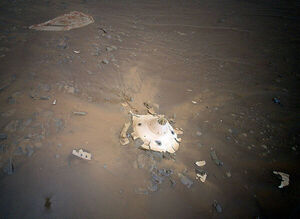
NASA’s Mars Helicopter Spots Gear That Helped Perseverance Rover Land
"Eyeing some of the components that enabled the rover to get safely to the Martian surface could provide valuable insights for future missions. NASA’s Ingenuity Mars Helicopter recently surveyed both the parachute that helped the agency’s Perseverance rover land on Mars and the cone-shaped backshell that protected the rover in deep space and during its fiery descent toward the Martian surface on Feb. 18, 2021. Engineers with the Mars Sample Return program asked whether Ingenuity could provide this perspective. What resulted were 10 aerial color images taken April 19 during Ingenuity’s Flight 26. “NASA extended Ingenuity flight operations to perform pioneering flights such as this,” said Teddy Tzanetos, Ingenuity’s team lead at NASA’s Jet Propulsion Laboratory in Southern California. “Every time we’re airborne, Ingenuity covers new ground and offers a perspective no previous planetary mission could achieve." [...]

NASA’s SpaceX Crew-4 Astronauts Launch to International Space Station
"NASA’s SpaceX Crew-4 astronauts are in orbit following their launch to the International Space Station at 3:52 a.m. EDT Wednesday, April 27, from Launch Complex 39A at NASA’s Kennedy Space Center in Florida. The international crew of astronauts will serve as the fourth commercial crew rotation mission aboard the space station. A SpaceX Falcon 9 rocket propelled the Dragon spacecraft into orbit carrying Mission Commander Kjell Lindgren, Pilot Bob Hines, and Mission Specialist Jessica Watkins, all NASA astronauts, and Mission Specialist Samantha Cristoforetti of ESA (European Space Agency). The crew will conduct a science expedition in microgravity aboard the space station. “Liftoff! The past few days at Kennedy Space Center have been inspiring and busy with the return of the Axiom crew and now the successful launch of Crew-4 astronauts to the International Space Station,” said NASA Administrator Bill Nelson." [...]
Outras Notícias

Nexperia widens its offering of discrete components in miniature DFN packaging with side-wettable flanks
"Rugged and reliable devices are AEC-Q101 compliant and save board space Nexperia, the expert in essential semiconductors, today announced its latest product additions to a growing range of discrete devices which it provides in leadless DFN packages with side-wettable flanks (SWF). These space-saving and rugged components help satisfy the needs of next generation applications in smart and electric vehicles. The AEC-Q101 range of devices available cuts across all Nexperia’s product groups and includes: - BC817QBH-Q and BC807QBH-Q series 45 V, 500 mA NPN/PNP general-purpose transistors in DFN1110D-3. - BAT32LS-Q and BAT42LS-Q general purpose Schottky diode in DFN1006BD-2 - BAS21LS-Q high-speed switching diode in DFN1006BD-2 package. - PDTA143/114/124/144EQB-Q series 50 V 100 mA PNP Resistor-Equipped Transistor (RET) family in DFN1110D-3 package. - 2N7002KQB – 60 V N-channel Trench MOSFET and BSS84AKQB – 50 V, P-channel Trench MOSFET in DFN1110D-3 package." [...]

Toshiba Releases New M3H Group of ARM Cortex-M3 Microcontrollers in the TXZ+ Family Advanced Class
"Toshiba Electronic Devices & Storage Corporation ("Toshiba") has started mass production of 21 new microcontrollers in the M3H group as new products in the TXZ+™ Family Advanced Class, manufactured in a 40nm process. The M3H group includes an ARM® Cortex®-M3 core running up to 120MHz, integrated max. 512KB code flash, and 32KB data flash memory with 100k write cycle endurance. These microcontrollers also offer various interface and motor control options, such as UART, I2C, Encoder, and Programmable Motor Control. M3H group devices are suited for a wide range of applications including motors, home appliances, and industrial equipment. In response to the diversity of consumer equipment, the new M3H group products have enhanced communications functions integrated as UART, TSPI, I2C, and a 2-unit DMAC." [...]

New Resilient, Redundant Source of Secure Network Timing and Synchronization for Power Operators is Now Available
"Microchip’s GridTime™ 3000 GNSS Time Server meets rugged international environmental standards for power plants and substations Power plants and substations rely on high-speed communications networks to transmit critical data including operability metrics, network health, fault monitoring, power measurement and usage trends. To synchronize communications and ensure continuity across these networks, substations require secure, precise timing and synchronization to avoid false tripping and to provide accurate timestamping of substation data including system faults, power measurement data and substation status information. To assist power grid operators to meet these requirements, Microchip Technology Inc. (Nasdaq: MCHP) today announced its GridTime™ 3000 GNSS Time Server – a software-configurable solution providing substations with a new level of redundancy, security, and resiliency. The GridTime 3000 system generates precise time and frequency signals to synchronize analog and digital communication systems. This resilient timing platform incorporates multiple timing inputs for protection in the event of a Global Navigation Satellite System (GNSS) signal disruption caused by severe weather, environmental disturbances or signal jamming or spoofing. Additionally, three levels of internal holdover options are available including a base Voltage Controlled Temperature Compensated Crystal Oscillator (VCTCXO) and an optional high-performance Oven Controlled Crystal Oscillator (OCXO) or Rubidium oscillator option to extend holdover duration and enhance performance." [...]

Renesas Debuts Automotive ECU Virtualization Solution Platform to Enable Secure Integration of Multiple Applications for Zone ECU
"Ready-to-Start Development Platform Includes Renesas High-Performance Automotive RH850/U2x MCUs along with RTA-HVR Software from ETAS Renesas Electronics Corporation (TSE:6723), a premier supplier of advanced semiconductor solutions, today announced an integrated automotive ECU Virtualization Platform that enables designers to integrate multiple applications into a single ECU (Electronic Control Unit) that are safely and securely separated from each other to avoid interference. The solution enables customers to adopt new electrical-electronic (E/E) architectures using MCU-based zone ECUs supporting multiple logical ECUs on one physical ECU. Migration to the new platform maximizes legacy reuse with minimum development effort to leverage gains in lower power consumption and reduced wiring harness weight and complexity in the vehicle. The ECU virtualization solution platform combines Renesas’ RH850/U2x MCUs together with ETAS’ RTA-HVR software, a hypervisor designed for microcontrollers with hardware virtualization support. This platform provides a ready-to-use demonstrator environment comprising pre-configured embedded software, tools and an interactive demonstrator environment for RH850/U2x MCUs, allowing automotive customers explore design choices for the development for their individual Zone-ECU project. “The transition to a zone architecture increases the design burden by changing the functional role assignments between the central ECU and each zone ECU,” said Satoshi Yoshida, Senior Director, Automotive Digital Products Marketing Division at Renesas." [...]
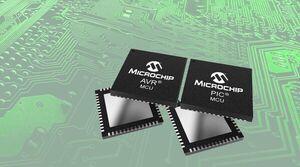
PIC and AVR Microcontrollers Anchor the Majority of Embedded Designs Today
"Microchip grows its commitment to the 8-bit PIC and AVR MCUs by releasing five new product families and over 60 new devices With smartphones, autonomous vehicles, and 5G wireless connectivity dominating the landscape of embedded design in 2022, Microchip’s 8-bit PIC® and AVR® microcontroller (MCU) families are gaining market share. Over the past 50 years, the market for 8-bit MCUs has grown steadily and Microchip currently sells one device for every human in the western hemisphere each year. To support this ongoing trend, Microchip Technology Inc. (Nasdaq: MCHP) today announces the release of five new product families and over 60 new individual devices that offer embedded designers simple solutions to their most common problems. Designers who are looking to create innovative designs are turning to Microchip’s new product families of PIC and AVR MCUs because of their processing power, ability to easily communicate with other chips, and analog peripherals that have been built to be exceptionally configurable without having to make changes to the Printed Circuit Board (PCB). These devices combine ASIC-like capabilities with a simple development experience that extends traditional MCU capabilities and allows them to be configured as smart peripheral chips. Smart peripherals, like the software-controlled op amp found on the PIC16F171 family, the Multi-Voltage I/O (MVIO) and Analog-to-Digital Converter with Computation (ADCC) add value to applications that otherwise would not use traditional MCUs." [...]

Greenland Ice, Jupiter Moon Share Similar Feature
"Parallel ice ridges, a common feature on Jupiter’s moon Europa, are found on Greenland’s ice sheet – and could bode well for Europa’s potential habitability. Parallel ice ridges in Greenland bear a striking resemblance to ridges on Jupiter’s ice-encased moon Europa, suggesting the moon’s icy shell could be riddled with pockets of water. This similarity could greatly improve the odds of NASA’s Europa Clipper mission detecting potentially habitable environments on the Jovian moon. The spacecraft’s ice-penetrating radar instrument REASON (short for Radar for Europa Assessment and Sounding: Ocean to Near-surface) will be ideal for conducting such a search. “If there are pockets of water under the ridges, we have the right instruments to see them,” said Dustin Schroeder, a Stanford University associate professor and coauthor of a new study comparing Greenland’s “double ridges” with those of Europa. Scientists say evidence gathered so far shows that Europa harbors a deep liquid ocean, hidden beneath an ice shell that could be 10 to 15 miles (15 to 25 kilometers) thick." [...]
Ciência e Tecnologia
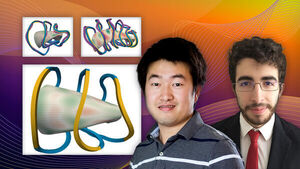
Researchers design simpler magnets for twisty facilities that could lead to steady-state fusion operation
"Harnessing the power that makes the sun and stars shine could be made easier by powerful magnets with straighter shapes than have been made before. Researchers linked to the U.S. Department of Energy’s (DOE) Princeton Plasma Physics Laboratory (PPPL) have found a way to create such magnets for fusion facilities known as stellarators. Such facilities have complex twisted magnetic coils, compared with the straight up-and-down coils in more widely used tokamak facilities, and can produce fusion reactions without the risk of disruptions that tokamaks face. This advantage makes stellarators a candidate to serve as the model for a next-generation fusion pilot plant. Now, by adding sections to the stellarator coils that are relatively straight, researchers could both reduce the manufacturing cost and make it easier to install openings that would allow technicians to repair the device’s interior. Both innovations could aid the development of a stellarator power plant, replicating fusion on Earth for a virtually inexhaustible supply of power to generate electricity without producing greenhouse gases or long-lived radioactive waste." [...]

UCI scientists turn a hydrogen molecule into a quantum sensor
"New technique enables precise measurement of electrostatic properties of materials. Physicists at the University of California, Irvine have demonstrated the use of a hydrogen molecule as a quantum sensor in a terahertz laser-equipped scanning tunneling microscope, a technique that can measure the chemical properties of materials at unprecedented time and spatial resolutions. This new technique can also be applied to analysis of two-dimensional materials which have the potential to play a role in advanced energy systems, electronics and quantum computers. Today in Science, the researchers in UCI’s Department of Physics & Astronomy and Department of Chemistry describe how they positioned two bound atoms of hydrogen in between the silver tip of the STM and a sample composed of a flat copper surface arrayed with small islands of copper nitride. With pulses of the laser lasting trillionths of a second, the scientists were able to excite the hydrogen molecule and detect changes in its quantum states at cryogenic temperatures and in the ultrahigh vacuum environment of the instrument, rendering atomic-scale, time-lapsed images of the sample. “This project represents an advance in both the measurement technique and the scientific question the approach allowed us to explore,” said co-author Wilson Ho, Donald Bren Professor of physics & astronomy and chemistry." [...]

Making 3D printing truly 3D
"Researchers from Rowland Institute eliminate need for 2D layering Don’t be fooled by the name. While 3D printers do print tangible objects (and quite well), how they do the job doesn’t actually happen in 3D, but rather in regular old 2D. Working to change that is a group of former and current researchers from the Rowland Institute at Harvard. First, here’s how 3D printing works: The printers lay down flat layers of resin, which will harden into plastic after being exposed to laser light, on top of each other, again and again from the bottom to the top. Eventually, the object, such as a skull, takes shape. But if a piece of the print overhangs, like a bridge or a wing of a plane, it requires some type of flat support structure to actually print, or the resin will fall apart." [...]
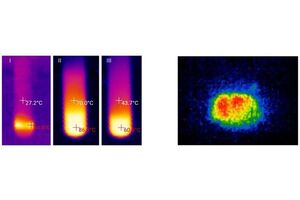
Chemists of St Petersburg University invent a thermal camera to carry out reactions
"The scientists of St Petersburg University together with the researchers from N.D. Zelinsky Institute of Organic Chemistry of the Russian Academy of Sciences have developed a tube-in-tube reactor that provides for efficient reactions without the use of external heaters. This approach significantly reduces energy costs when performing chemical research. Chemical reactions may proceed with heat release (exothermic) or with heat consumption (endothermic). In the first case, the resulting thermal emissions often dissipate. However, they can be used to launch the reactions of the second type requiring additional heat for absorption. The structure developed by the chemists looks like a thermos allowing for the use of released heat energy to launch the second reaction." [...]

Electronics can grow on trees thanks to nanocellulose paper semiconductors
"A team including researchers from Osaka University reports wood-derived semiconductors that can be tuned for use in a range of sustainable electronic devices. Semiconducting nanomaterials with 3D network structures have high surface areas and lots of pores that make them excellent for applications involving adsorbing, separating, and sensing. However, simultaneously controlling the electrical properties and creating useful micro- and macro-scale structures, while achieving excellent functionality and end-use versatility, remains challenging. Now, Osaka University researchers, in collaboration with The University of Tokyo, Kyushu University, and Okayama University, have developed a nanocellulose paper semiconductor that provides both nano−micro−macro trans-scale designability of the 3D structures and wide tunability of the electrical properties. Their findings are published in ACS Nano. Cellulose is a natural and easy to source material derived from wood." [...]

Stanford scientist models landscape formation on Titan, revealing an Earth-like alien world
"A new hypothesis reveals that a global sedimentary cycle driven by seasons could explain the formation of landscapes on Saturn’s moon Titan. The research shows the alien world may be more Earth-like than previously thought. Saturn’s moon Titan looks very much like Earth from space, with rivers, lakes, and seas filled by rain tumbling through a thick atmosphere. While these landscapes may look familiar, they are composed of materials that are undoubtedly different – liquid methane streams streak Titan’s icy surface and nitrogen winds build hydrocarbon sand dunes. The presence of these materials – whose mechanical properties are vastly different from those of silicate-based substances that make up other known sedimentary bodies in our solar system – makes Titan’s landscape formation enigmatic. By identifying a process that would allow for hydrocarbon-based substances to form sand grains or bedrock depending on how often winds blow and streams flow, Stanford University geologist Mathieu Lapôtre and his colleagues have shown how Titan’s distinct dunes, plains, and labyrinth terrains could be formed." [...]

Cheaper hydrogen fuel cell could mean better green energy options
"Imperial researchers have developed a hydrogen fuel cell that uses iron instead of rare and costly platinum, enabling greater use of the technology. Hydrogen fuel cells convert hydrogen to electricity with water vapour as the only by-product, making them an attractive green alternative for portable power, particularly for vehicles. However, their widespread use has been hampered in part by the cost of one of the primary components. To facilitate the reaction that produces the electricity, the fuel cells rely on a catalyst made of platinum, which is expensive and scarce. Now, a European team led by Imperial College London researchers has created a catalyst using only iron, carbon, and nitrogen – materials that are cheap and readily available – and shown that it can be used to operate a fuel cell at high power. Their results are published today in Nature Catalysis." [...]

LightPC Presents a Resilient System Using Only Non-Volatile Memory
"Lightweight Persistence Centric System (LightPC) ensures both data and execution persistence for energy-efficient full system persistence A KAIST research team has developed hardware and software technology that ensures both data and execution persistence. The Lightweight Persistence Centric System (LightPC) makes the systems resilient against power failures by utilizing only non-volatile memory as the main memory. “We mounted non-volatile memory on a system board prototype and created an operating system to verify the effectiveness of LightPC,” said Professor Myoungsoo Jung. The team confirmed that LightPC validated its execution while powering up and down in the middle of execution, showing up to eight times more memory, 4.3 times faster application execution, and 73% lower power consumption compared to traditional systems. Professor Jung said that LightPC can be utilized in a variety of fields such as data centers and high-performance computing to provide large-capacity memory, high performance, low power consumption, and service reliability. In general, power failures on legacy systems can lead to the loss of data stored in the DRAM-based main memory." [...]
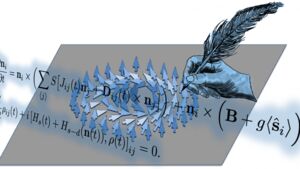
Researchers create exotic magnetic structures with laser light
"Research at Lund University in Sweden has found a new way to create nano-sized magnetic particles using ultrafast laser light pulses. The discovery could pave the way for new and more energy-efficient technical components and become useful in the quantum computers of the future. Magnetic skyrmions are sometimes described as magnetic vortices. Unlike ferromagnetic states - which occur in conventional magnets such as compasses and refrigerator magnets - the skyrmion state is quite peculiar: the orientation of the magnetization does not point in the same direction everywhere in the material, but is instead best described as a kind of swirling magnetism. Skyrmions are of great interest to both basic research and industry, as they can be used to manufacture more compact computer memories. However, that is easier said than done." [...]
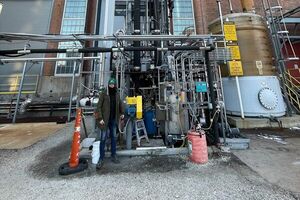
Technology to absorb CO2 at power plants is promising
"Illinois Sustainable Technology Center (ISTC) researchers have given the thumbs up to an innovative biphasic solvent system for its efficiency and effectiveness in absorbing CO₂ from flue gas in a coal-fired power plant at the University of Illinois (U of I). With $3.4 million from the U.S. Department of Energy (DOE) National Energy Technology Laboratory, an ISTC team sought to validate the various advantages of a biphasic CO₂ absorption process (BiCAP) at a 40-kilowatt electric small pilot scale at the Abbott Power Plant on the U of I campus. The system was designed based on the testing results at the laboratory scale under a previous DOE cooperative agreement. Previous laboratory testing has proved the biphasic solvent-based process concept and has shown that the technique can achieve greater than 90 percent capture efficiency and greater than 95 percent CO₂ purity and has the potential to significantly increase energy efficiency and reduce CO₂ capture cost. From the recent field testing, the team verified that their technology could achieve 95 percent efficiency in CO₂ capture, compared with 90 percent in conventional methods, with a 40 percent higher energy efficiency. The cost advantages have not yet been determined, but previous laboratory testing showed a 26 percent cost reduction." [...]
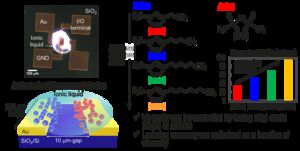
Ionic Liquid-Based Reservoir Computing: The Key to Efficient and Flexible Edge Computing
"Researchers from Japan design a tunable physical reservoir device based on the dielectric relaxation at an electrode-ionic liquid interface Physical reservoir computing (PRC), which relies on the transient response of physical systems, is an attractive machine learning framework that can perform high-speed processing of time-series signals at low power. However, PRC systems have low tunability, limiting the signals it can process. Now, researchers from Japan present ionic liquids as an easily tunable physical reservoir device that can be optimized to process signals over a broad range of timescales by simply changing their viscosity. Artificial Intelligence (AI) is fast becoming ubiquitous in the modern society and will feature a broader implementation in the coming years. In applications involving sensors and internet-of-things devices, the norm is often edge AI, a technology in which the computing and analyses are performed close to the user (where the data is collected) and not far away on a centralized server. This is because edge AI has low power requirements as well as high-speed data processing capabilities, traits that are particularly desirable in processing time-series data in real time." [...]
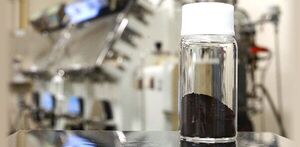
Researchers Unlock Potential Means to Reduce Lithium-Ion Batteries Reliance on Rare Metals
"A research group, utilizing inexpensive elements, has demonstrated the feasibility of synthesizing electrode materials for lithium-ion batteries (LIBs). If explored further, this method could reduce industrial reliance on rare metals such as cobalt and nickel. Details of their results were published in the American Chemical Society's journal "ACS Applied Energy Materials" on April 11, 2022. Rare metals are widely used because they form a suitable crystal structure for LIBs' key component - cathode materials. In these materials, lithium is easily and reversibly extracted/inserted. Scientists have long sought ways to incorporate other inexpensive elements into the crystal structure." [...]

See how quantum 'weirdness' is improving electron microscopes
"Quantum weirdness is opening new doors for electron microscopes, powerful tools used for high-resolution imaging. Two new advances from the lab of UO physicist Ben McMorran are refining the microscopes. Both come from taking advantage of a fundamental principle of quantum mechanics: that an electron can behave simultaneously like a wave and a particle. It’s one of many examples of weird, quantum-level quirks in which subatomic particles often behave in ways that seem to violate the laws of classical physics. One of the studies finds a way to study an object under the microscope without making contact with it, preventing the scope from damaging fragile samples. And the second devises a way to make two measurements on a sample at once, giving a way to study how particles in that object are potentially interacting across distances." [...]
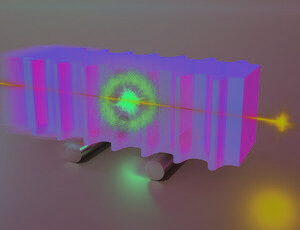
In Einstein’s footsteps and beyond
"Zero-index metamaterials offers new insights into the foundations of quantum mechanics In physics, as in life, it’s always good to look at things from different perspectives. Since the beginning of quantum physics, how light moves and interacts with matter around it has mostly been described and understood mathematically through the lens of its energy. In 1900, Max Planck used energy to explain how light is emitted by heated objects, a seminal study in the foundation of quantum mechanics. In 1905, Albert Einstein used energy when he introduced the concept of photon. But light has another, equally important quality known as momentum. And, as it turns out, when you take momentum away, light starts behaving in really interesting ways." [...]
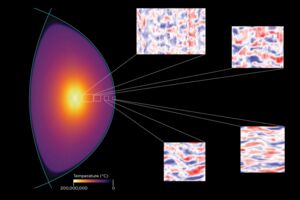
Machine learning, harnessed to extreme computing, aids fusion energy development
"Linking techniques from machine learning with advanced numerical simulations, MIT researchers take an important step in state-of-the-art predictions for fusion plasmas. MIT research scientists Pablo Rodriguez-Fernandez and Nathan Howard have just completed one of the most demanding calculations in fusion science — predicting the temperature and density profiles of a magnetically confined plasma via first-principles simulation of plasma turbulence. Solving this problem by brute force is beyond the capabilities of even the most advanced supercomputers. Instead, the researchers used an optimization methodology developed for machine learning to dramatically reduce the CPU time required while maintaining the accuracy of the solution. Fusion energy Fusion offers the promise of unlimited, carbon-free energy through the same physical process that powers the sun and the stars. It requires heating the fuel to temperatures above 100 million degrees, well above the point where the electrons are stripped from their atoms, creating a form of matter called plasma." [...]

Discovery of the one-way superconductor, thought to be impossible
"Associate Professor Mazhar Ali and his research group at TU Delft have discovered one-way superconductivity without magnetic fields, something that was thought to be impossible ever since its discovery in 1911 – up till now. The discovery, which was published in Nature yesterday, makes use of 2D quantum materials and paves the way towards superconducting computing. Superconductors can make electronics hundreds of times faster, all with zero energy loss. Ali: “If the 20th century was the century of semi-conductors, the 21st can become the century of the superconductor.” During the 20th century many scientists, including Nobel Prize winners, have puzzled over the nature of superconductivity, which was discovered by Dutch physicist Kamerlingh Onnes in 1911 (read more about this in the frame below). In superconductors, a current goes through a wire without any resistance, which means inhibiting this current or even blocking it is hardly possible – let alone getting the current to flow only one way and not the other. That Dr. Heng Wu and Dr. Yaojia Wang, the lead researchers in Ali’s group who carried out this study, managed to make superconducting one-directional – necessary for computing – is remarkable: one can compare it to inventing a special type of ice which gives you zero friction when skating one way, but insurmountable friction the other way." [...]

Advancing materials science for superconducting quantum circuits
"NPL scientists, in collaboration with experts in physical chemistry, have unleashed state-of-the-art electron paramagnetic resonance (EPR) techniques to understand materials relevant for superconducting quantum circuits, with results published in a recent paper in Science Advances. Superconducting quantum computers have rapidly increased in size and complexity in recent years and the focus is now towards demonstrating fault-tolerant error-corrected quantum computing. Progress is currently held back by a relatively short coherence time and state fidelity of qubits. These obstacles are largely attributed to atomic-scale material defects interacting with the qubits. The origin of these defects is notoriously difficult to explore because of their quantum nature: They only reveal themselves at the energy scales and conditions relevant for the qubits themselves and are so far largely inaccessible by techniques available to material scientists. By utilising the inherent high resolution provided by high magnetic field EPR, in combination with nuclear spectroscopy techniques, the team were able to study a specific surface radical on Al2O3 (a material present in all modern superconducting quantum processors) in detail." [...]

Physicists embark on a hunt for a long-sought quantum glow
"A new approach could make it possible to detect the elusive Unruh effect in hours, rather than billions of years. For “Star Wars” fans, the streaking stars seen from the cockpit of the Millennium Falcon as it jumps to hyperspace is a canonical image. But what would a pilot actually see if she could accelerate in an instant through the vacuum of space? According to a prediction known as the Unruh effect, she would more likely see a warm glow. Since the 1970s when it was first proposed, the Unruh effect has eluded detection, mainly because the probability of seeing the effect is infinitesimally small, requiring either enormous accelerations or vast amounts of observation time. But researchers at MIT and the University of Waterloo believe they have found a way to significantly increase the probability of observing the Unruh effect, which they detail in a study appearing today in Physical Review Letters." [...]
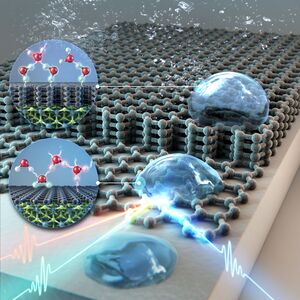
Measuring the ‘wettability’ of graphene and other 2D materials
"Wettability of the material is the ability of a liquid to maintain contact with a solid surface, and it is proportional to hydrophilicity and inversely proportional to hydrophobicity. It is one of the most important properties of a solid, and understanding the wettability of different substrates is essential for various industrial uses, such as desalination, coating agents, and water electrolytes. So far, studies on the wettability of substrates have mainly been measured at the macroscopic level. The macroscopic measurement of wettability is typically determined by measuring the water contact angle (WCA), which is the angle a water droplet makes with respect to the surface of the substrate. However, it is currently very difficult to accurately measure what happens at the interface between a substrate and water at the molecular level. Currently used microscopic measurement techniques, such as reflection-based infrared spectroscopy or Raman spectroscopy, are incapable of selectively observing the interfacial water molecules." [...]
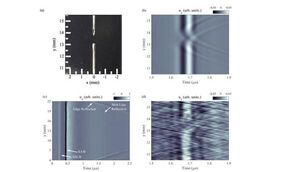
Laser-based ultrasound detects defect-producing features in metal 3D printing
"Lawrence Livermore National Laboratory (LLNL) researchers have developed a new all-optical ultrasound technique capable of performing on-demand characterization of melt tracks and detecting formation of defects in a popular metal 3D printing process. In a paper published by Scientific Reports, Lab researchers propose a diagnostic using surface acoustic waves (SAW), generated by laser-based ultrasound, that can reveal tiny surface and sub-surface defects in laser powder bed fusion (LPBF) metal 3D-printing. The team reported the system they developed can effectively and accurately evaluate laser melt lines — the tracks where the laser liquifies metal powder in LPBF printing — by scattering acoustic energy from melt lines, voids and surface features that can be quickly detected. The team validated the findings using optical microscopy and X-ray computed tomography (CT). “We hope that this work demonstrates the potential for an all-optical ultrasound system capable of rapid, on-demand in situ characterization of LPBF processes and powders,” said LLNL engineer and principal investigator David Stobbe. “The demonstrated laser-based ultrasound, surface acoustic wave system showed excellent sensitivity to surface and near-surface features, including breaks in the LPBF melt line, metal surface splatter and subsurface air voids.” Surface acoustic waves have historically been used to characterize surface and near-surface features such as cracks, pits and welds in engineering materials, and are used in geology — at a much larger length scale — for detecting subterranean features such as caves." [...]

Large Hadron Collider Restarts
"The world’s largest and most powerful particle accelerator has restarted after a break of more than three years for maintenance, consolidation and upgrade work. Today, 22 April, at 12:16 CEST, two beams of protons circulated in opposite directions around the Large Hadron Collider’s 27-kilometre ring at their injection energy of 450 billion electronvolts (450 GeV). “These beams circulated at injection energy and contained a relatively small number of protons. High-intensity, high-energy collisions are a couple of months away,” says the Head of CERN’s Beams department, Rhodri Jones. “But first beams represent the successful restart of the accelerator after all the hard work of the long shutdown.” “The machines and facilities underwent major upgrades during the second long shutdown of CERN’s accelerator complex,” says CERN’s Director for Accelerators and Technology, Mike Lamont. “The LHC itself has undergone an extensive consolidation programme and will now operate at an even higher energy and, thanks to major improvements in the injector complex, it will deliver significantly more data to the upgraded LHC experiments.” Pilot beams circulated in the LHC for a brief period in October 2021." [...]
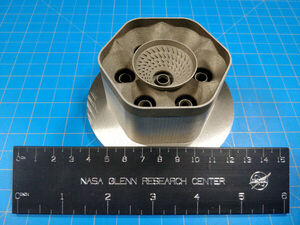
NASA’s New Material Built to Withstand Extreme Conditions
"NASA innovators recently developed a new metal alloy using a 3D printing process that dramatically improves the strength and durability of the components and parts used in aviation and space exploration, resulting in better and longer-lasting performance. NASA Alloy GRX-810, an oxide dispersion strengthened (ODS) alloy, can endure temperatures over 2,000 degrees Fahrenheit, is more malleable, and can survive more than 1,000 times longer than existing state-of-the-art alloys. These new alloys can be used to build aerospace parts for high temperature applications, like those inside aircraft and rocket engines, because ODS alloys can withstand harsher conditions before reaching their breaking point. “The nanoscale oxide particles convey the incredible performance benefits of this alloy,” said Dale Hopkins, deputy project manager of NASA’s Transformational Tools and Technologies project. It's challenging and expensive to produce ODS alloys for these extreme environments. To develop NASA Alloy GRX-810, agency researchers used computational models to determine the alloy’s composition." [...]
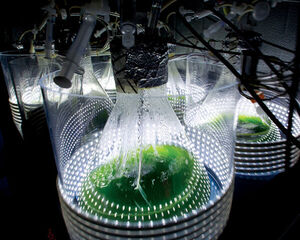
Bioplastics point the way to an environmentally sustainable, green future
"AI accelerates research into Earth-friendly materials that soak up CO2 and break the dependence on fossil feedstocks for everyday products Getting a grip on climate change depends on shifting from CO2-emitting fossil fuels to renewable energy sources. When that happens, where will we get all the plastic we need for, well, nearly everything? Most plastics today come from petroleum. About three-quarters of every barrel of oil goes to make gasoline, diesel and jet fuel; the remaining quarter goes to other products, including plastic. Making it from petroleum is doubly problematic as it helps perpetuate our global dependence on fossil energy and it continues the long-term environmental degradation caused by synthetic plastics, which can take several hundred years to break down into simpler materials. The entwined challenges of transitioning to renewable, non-fossil energy sources and developing environmentally friendly plastics highlight the breadth of the broader challenge of decarbonizing our economy for a sustainable future." [...]
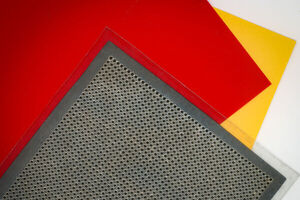
Researchers develop a paper-thin loudspeaker
"The flexible, thin-film device has the potential to make any surface into a low-power, high-quality audio source. MIT engineers have developed a paper-thin loudspeaker that can turn any surface into an active audio source. This thin-film loudspeaker produces sound with minimal distortion while using a fraction of the energy required by a traditional loudspeaker. The hand-sized loudspeaker the team demonstrated, which weighs about as much as a dime, can generate high-quality sound no matter what surface the film is bonded to. To achieve these properties, the researchers pioneered a deceptively simple fabrication technique, which requires only three basic steps and can be scaled up to produce ultrathin loudspeakers large enough to cover the inside of an automobile or to wallpaper a room. Used this way, the thin-film loudspeaker could provide active noise cancellation in clamorous environments, such as an airplane cockpit, by generating sound of the same amplitude but opposite phase; the two sounds cancel each other out." [...]
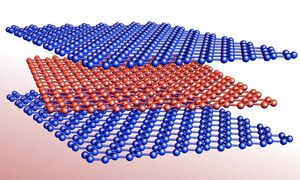
Glimpse inside a graphene sandwich
"In the search for novel types of superconductors – phases of matter that that conduct electric current without loss – scientists are investigating materials that consist of multiple layers. A team led by theoretical physicist Mathias Scheurer has studied in detail the properties of a system of three twisted graphene layers and gained important insights into its properties. Since the first successful fabrication of a two-dimensional structure of carbon atoms about 20 years ago, graphene has fascinated scientists. A few years ago, researchers discovered that two layers of graphene, slightly twisted against each other, can conduct electric current without loss. In recent years, this discovery has prompted scientists to explore such layered materials in greater detail. A recent notable example is mirror-symmetric twisted trilayer graphene, where three layers of graphene are stacked with alternating twist angles." [...]
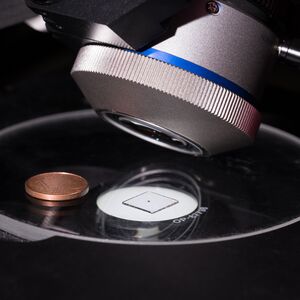
Researchers Add Antireflection Coatings to Complex 3D Printed Micro-Optical Systems
"New low-temperature coating technique poised to enable high-quality 3D printed microlens systems for applications from endoscopes to virtual reality Researchers have developed a new way to apply antireflective (AR) coatings to 3D printed multi-lens systems as small as 600 microns in diameter. Because these coatings help minimize light losses due to reflection, they are critical for making high-quality 3D printed systems consisting of multiple microlenses. “Our new method will benefit any 3D printed complex optical system that uses multiple lenses,” said research team leader Harald Giessen from the University of Stuttgart in Germany. “However, it is especially useful for applications such as miniature fiber endoscopes, which require high-quality optics and are used for imaging under less-than-ideal lighting conditions.” Large lenses like the ones used in a camera are coated before they are assembled into a device. However, for 3D printed lenses less than 1 millimeter wide, conventional coating techniques such as sputtering cannot be used. This is because the whole lens system is typically printed in a single step that forms hard-to-reach hollow openings and undercuts." [...]
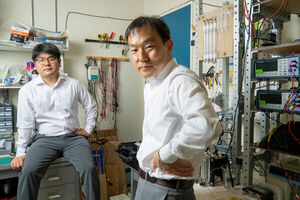
From seawater to drinking water, with the push of a button
"Researchers build a portable desalination unit that generates clear, clean drinking water without the need for filters or high-pressure pumps. MIT researchers have developed a portable desalination unit, weighing less than 10 kilograms, that can remove particles and salts to generate drinking water. The suitcase-sized device, which requires less power to operate than a cell phone charger, can also be driven by a small, portable solar panel, which can be purchased online for around $50. It automatically generates drinking water that exceeds World Health Organization quality standards. The technology is packaged into a user-friendly device that runs with the push of one button. Unlike other portable desalination units that require water to pass through filters, this device utilizes electrical power to remove particles from drinking water." [...]

Successful mass production of ultra-high-purity diamond wafers with a diameter of 2 inches Aiming to realize a quantum computer
"Adamant Namiki Precision Jewelery Co., Ltd. (Adachi-ku, Tokyo, President Ryako Namiki) has developed a mass production technology for ultra-high purity diamond wafers with a diameter of 2 inches. Quantum memory * 2 used in quantum computers * 1 and ultra-high-sensitivity magnetic sensors use ultra-high-purity diamonds with a nitrogen concentration of 3 ppb or less (ppb = 1 billion percent), and development is accelerating. Until then, usable diamond crystals were only about 4 mm square. This time, we have developed a diamond wafer with ultra-high purity and a diameter of 2 inches (about 55 mm). It is expected that it will lead to the realization of quantum computers in the future. This product is scheduled to be commercialized in 2023." [...]
Documentação
A documentação é parte essencial do processo de aprendizagem e a Internet além de artigos interessantes de explorar também tem alguma documentação em formato PDF interessante de ler. Todos os links aqui apresentados são para conteúdo disponibilizado livremente pelo editor do livro.
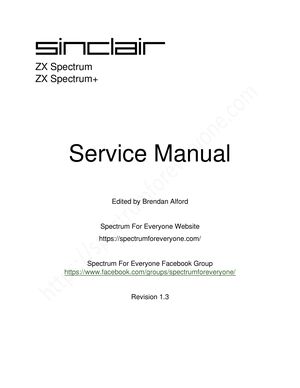
Sinclair ZX Spectrum Service Manual
"Sinclair ZX Spectrum Service Manual" [...]

HackSpace magazine #54
"What could be more satisfying than building a whole computer, from scratch? You might think it’s impossible these days, but we’ve found a band of makers who are re-creating the clicky switches and flashing LEDs of a bygone age. Have a go yourself! - Design, sustainability and ethics with Jude Pullen - Add much-needed safety features to a cheap off-the-internet laser cutter - Send communication signals through the ground - Get going with gears" [...]
Projetos Maker
Diversos Projetos interessantes.

rpitx
"rpitx is a general radio frequency transmitter for Raspberry Pi which doesn't require any other hardware unless filter to avoid intererence. It can handle frequencies from 5 KHz up to 1500 MHz. Rpitx is a software made for educational on RF system. It has not been tested for compliance with regulations governing transmission of radio signals. You are responsible for using your Raspberry Pi legally. " [...]

Get started with Tensorflow lite/micro by Sony Spresense
"This is a tutorial for MNIST data recognition using Tensorflow lite/micro on Sony Spresense Main Board. This project describes how to model a neural network using Tensorflow 2.8.0 (Keras), generated the trained model, and tried to run it on Sony Spresense. Tensorflow has become much easier to understand since Keras 2.0, but porting it to microcontrollers has been a challenge. Many people may have been frustrated by the incomprehensibility of the Tensorflow lite/micro code. This time, I introduce Spresense's Arduino customized board package I made that is very easy to program by Arduino IDE, and explain how to program it. This project separates into two parts." [...]

Publish Data from Wio Terminal to Qubitro IoT Platform
"Publish built-in sensors' Wio Terminal data to Qubitro IoT platform through MQTT protocol. In this tutorial, we're gonna learn how to publish sensor readings from Wio Terminal to Qubitro IoT platform through MQTT protocol. Qubitro is the fastest way to build IoT applications with predictable pricing, developer-friendly features, and scalability you’ll love. You can connect your hardware to Qubitro, collect the data and create data visualization on your own dashboard. For more information about Qubitro you can check on its official site: qubitro.com. We're gonna use the Wio Terminal, a SAMD51-based microcontroller with Realtek RTL8720DN wireless connectivity by Seeed Studio." [...]

Displaying messages sent from IoT-Cloud on an LCD
"This project will show you how to set up an Arduino IoT cloud dashboard to send messages to a Liquid Crystal Display (LCD). The project connects a liquid crystal display to the Arduino IoT Cloud. The end result is that you will be able to send messages from the dashboard on the Arduino IoT Cloud to the LCD. You will need an Arduino board that is IoT Cloud compatible, we are using the Nano 33 IoT for this project. " [...]

Maker Your Own Professional Bench Power Supply
"Maker Your Own DIY Professional Every workbench should have at least one power supply. When you’re experimenting with electronics and microcontrollers a good power supply can be an essential piece of equipment. While you can certainly make do with USB power bricks and “battery eliminators” nothing beats having a dedicated power supply with plenty of voltage selection and current capability. An ideal workbench power supply should have both 5-volt and 12-volt outputs, with 3.3-volts being a nice option as well. It should be capable of providing several amperes of current for each voltage. You can buy bench power supplies of course, but they are not inexpensive." [...]
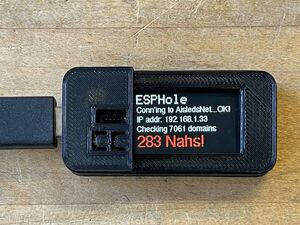
ESPHole Ad Blocker
"Using the web can be incredibly distracting, or even outright dangerous thanks to ever-present advertisments and trackers. In this EFF article by friend-of-the-Fruit Cory Doctorow, the problem and solution are spelled out thusly: As the online world has grown more concentrated, with more and more power in fewer and fewer hands, it's become increasingly difficult for Web publishers to resist advertisers' insistence on obnoxious tracking ads. But Internet users have never been willing to accept take-it-or-leave-it as the last word in technological self-determination. Adblockers are the new pop-up blockers, a way for users to do what publishers can't or won't do: demand a better deal from advertisers. When you visit a site, the deal on offer is, "Let us and everyone we do business with track you in every way possible or get lost" and users who install adblockers push back. An adblocker is a way of replying to advertisers and publishers with a loud-and-clear "How about nah?"" [...]

Generating true random numbers from bananas
"It was a dreary afternoon in Milan last year when, procrastinating on studying, I was struck by a flash of genius. “What would happen if I made a banana-powered random number generator?“. I immediately went to tell my roommate, who was also an electronic engineer. He looked me in the face and burst out laughing. At that moment I realized that I had a great project in my hands. Before being taken for a fool: it really does make sense, and this post is here to explain it to you." [...]

Tiny I2C Routines for all AVR Microcontrollers
"This article describes a set of minimal I2C routines that allow just about any Microchip/Atmel AVR processor to connect to I2C peripherals. To demonstrate the routines I've designed a port scanner that displays the I2C address of a sensor on a dot-matrix display, and a digital thermometer that reads the temperature from an I2C temperature sensor and displays it. The main difference between these routines and the standard Arduino Wire library is that these don't use buffers, so have much smaller memory requirements and don't impose a limit on transmissions. Compatibility These I2C routines are designed to provide master I2C functionality for all Microchip/Atmel AVR processors. Over the years different generations of AVR chips have featured three different, incompatible peripherals to handle I2C: Universal Serial interface (USI) peripheral The USI provides master I2C support to ATtiny processors with a USI peripheral, namely: - ATtiny25/45/85 and ATtiny24/44/84 - ATtiny261/461/861 - ATtiny87/167 - ATtiny2313/4313 - ATtiny1634 The routines to support the USI are based on the code described by Atmel Application Note AVR310 [1]. 2-Wire Serial Interface (TWI) peripheral This provides full master I2C support, and is featured in: - Most of the original ATmega processors, such as the ATmega328P used in the Arduino Uno, ATmega2560 used in the Arduino Mega 2560, and the ATmega1284P." [...]
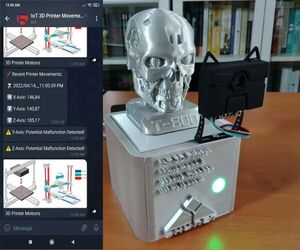
AI-driven IoT 3D Printer Motion & Status Tracker W/ Telegram
"Track lateral and vertical movements of a 3D printer via AprilTags. Then, get informed of malfunctions related to motion via Telegram. Supplies 1 x Raspberry Pi Pico 1 x WIZnet Ethernet HAT 1 x DFRobot HuskyLens AI Camera 1 x Raspberry Pi 3B+ or 4 1 x Creality CR-6 SE 3D Printer 1 x Keyes 10mm RGB LED Module (140C05) 1 x Buzzer 1 x LAN Ethernet Cable 1 x Xiaomi 20000 mAh 3 Pro Type-C Power Bank 1 x USB Buck-Boost Converter Board 2 x Mini Breadboard 1 x Jumper Wires" [...]
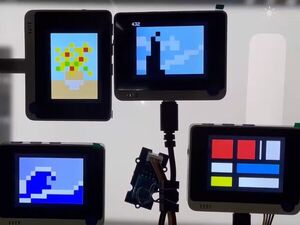
Wio Terminal Art Collection
"Electronics can be art. Art projects by postgraduate in Sichuan Fine Arts Institute. "Electronics can be art. " It's proven true by a group of postgraduates in Sichuan Fine Arts Institute. Led by Bowen Shen, 20 postgraduates who master in Technological and Interactive Arts participated in a 2-week-long workshop to learn about edge machine learning on Wio Terminal. By combining the tinyML tech and art, a team of postgraduates created this amazing project which I named Wio Terminal Art Collections." [...]
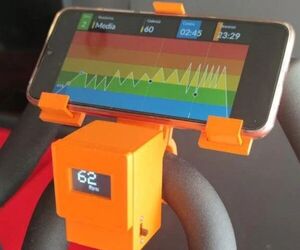
RPM Spinning
"As one of the rest of the world, we end up being at home and changing certain areas. One of them in my case has been the way of practicing sports, instead of going to the gym, I went to buy a spinning bike and online classes. Now, a few months after the purchase, I have decided to improve it by adding a revolutions per minute counter (essential for spinning) and a mobile phone holder. The design consists of a screen that shows the rpms and meters (optional) controlled by a mini micro board (powered by a 9v battery) and a hall sensor that will detect the pedaling. We will need a 3d printer, and some electronic components among them: - pro micro plate - OLED display 0.96" 128x64 I2C - hall sensor - A neodymium magnet - 2 switches - Connectors - 1 Battery 9v 6LR61 - battery connector - some screws" [...]

Two Digits Led display with PICO and LB-402-MD
"This is a Raspberry Pico project, with a micropython app to manage the LB-402-Dn series two-digits led display. In the example LB-402-MD. LB-402DN series: This is a two digit led display, that can be managed in common anode ot cathode in general. The series has red and green color. Digit 1, left (most significant in two digits numbers) has pin a1 to f1 (point dp1), Digit 2, right, has pin assignements from a2 to f2 (dp2). This is a Raspberry Pico implementantion with micropython, for LB-402-MD." [...]
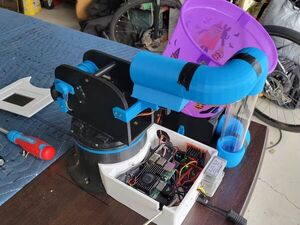
How to Almost Build a Beer Pong Playing Robot
"An attempt to build a beer pong playing robot with questionable results. How to Almost Build a Beer Pong Playing Robot In April of 2021 I was looking for a project to spend my ample amount of free time on. For some reason a beer pong playing robot popped into my head. At a high level I envisioned a robot that would use a camera to find cups and fire a ping pong ball at said cups. I decided a Raspberry Pi would be used as the “brain” and would handle the image processing. The Raspberry Pi would tell an Arduino how to orientate the firing mechanism." [...]

Project Eden: Smart Garden
"Project Eden is a fully IoT equipped station that has the ability to monitor the humidity, moisture and temperature surrounding the soil. It also parses data from Willyweather (local weather station) to determine if a rain event is occuring, and interlock the pump if so. There is a graphical interface I have setup on node-red to allow 24/7 monitoring, data collection and control of the plant. The peristaltic pump has the ability to draw water from a bucket, which contains a float level switch in order to keep track of the water available for the pump. Materials - IP56 Rated Junction Box ($20) - Wemos D1 Mini ($10) - DHT11 Temperature & Humidity Sensor ($10) - Soil Moisture Sensor ($5) - 5V Relay ($5) - Cable Gland ($2) - 6V Grothen Peristaltic Pump ($20) - Spare/Scrap Wood - 5V Power Supply ($10) - Jumper Wires - Raspberry Pi or Laptop for node-red server - Vinyl Tubing Composition Below is the schematic of the electronic components. First lets talk about the pump." [...]

LCARS MQTT Intercom with Wio Terminal
"Create your own LCARS wireless intercom like Captain Picard - easy and non-intrusive communication around your SmartHome. In today’s article, we are going to build an Arduino LCARS wireless intercom with our Wio Terminal ! Feel like Captain Picard in your SmartHome. This project sets up your Wio Terminal as a desk clock, but also allows you to send and receive messages to other devices via the MQTT protocol. The project is an upgrade of the pre work from Jonathan Tan. What’s an Intercom ?" [...]

Vectron VGA Plus v2
"Vectron VGA Plus v2 generates a 640x480@60Hz VGA signal and has an interface that works with retro computers or Arduino. How It Works Vectron VGA Plus v2 is an improvement on the earlier design. The key to the simplified design of the Vectron VGA Plus boards is to use more RAM and less logic. So, for example, instead of having counters and flip flops, etc. to time each horizontal sync, that logic is embedded in the data in memory. Memory addresses are sequentially incremented by an osciallator, and the contents of each memory address specify what signals to output (R/G/B/H sync/V sync)." [...]

ESP32-cam Standalone With Robot Arm
"The ESP32cam is a very nice processor and camera which should be useful in a wide range of robotics projects. But when you look on the web most ESP32cam projects are very similar: "here's an ESP32cam, let's connect it to a PC over Wi-Fi and use the PC to recognise a face or record video". The ESP32cam is acting as not much more than a wireless webcam. It is simply a peripheral to a PC. It should be capable of more than that. It ought to be very useful in robots that are not tethered to a PC through Wi-Fi." [...]
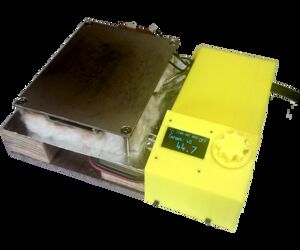
Tim's Hot Plate
"I wanted a heating plate for soldering my PCBs with SMD components. This is show you how to build and control the temperature of cheep PTC heater. Supplies - Aluminium PTC Heater There are many types and sizes. Can use a different size but will need to alter the mounting points to suite. - Arduino Nano R3 I have used the 168 version. I will do HEX files for the different versions." [...]

Modular Solar/UPS for Raspberry Pi 4B
"Do you want to build a uninterruptible power supply (UPS) system which will keep your Raspberry Pi 4B online 24/7/365 without hassle? This isn't one of those gimmicky tutorials which uses a tiny cell phone charger with an 18650 battery built in that is technically capable of powering a potato... No, I'm using some heavy duty materials which will feed the power hungry Raspberry Pi 4B, 24/7. I see many tutorials online for building a Raspberry Pi UPS with different components. But I am a person who likes to do things as simply as possible. That is why this design has no complicated wiring. Since no soldering iron is needed, it is safe for kids, and for people who have a very basic knowledge of electronics." [...]
Secção Videos
Videos interessantes.
That's all Folks!



